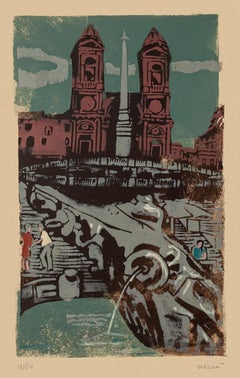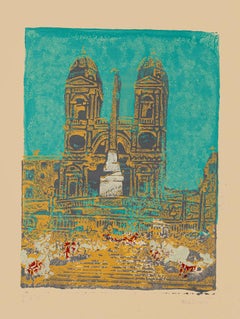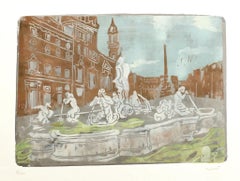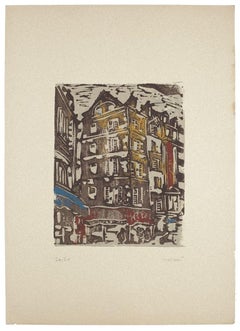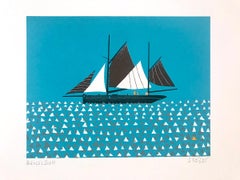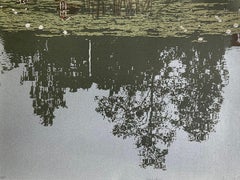Carlo Mazzoni Art
to
2
1
1
Overall Width
to
Overall Height
to
4
1
1
3
1
2
2
1
1
1
1
3
2
1
4
9,478
2,687
1,375
1,358
4
Artist: Carlo Mazzoni
Trinità dei Monti - Original Screen Print by Carlo Mazzoni - Late 20th Century
By Carlo Mazzoni
Located in Roma, IT
Trinità dei Monti is an original screen print realized by Carlo Mazzoni.
Hand-signed by the artist in pencil on the lower right corner.
Edition 19/60
Good conditions.
This artwo...
Category
Late 20th Century Carlo Mazzoni Art
Materials
Paper, Screen
Trinità dei Monti - Original Screen Print by Carlo Mazzoni - Late 20th Century
By Carlo Mazzoni
Located in Roma, IT
Trinità dei Monti is an original screen print realized by Carlo Mazzoni.
Hand-signed by the artist in pencil on the lower right corner.
Artist's proof.
Good conditions.
This art...
Category
Late 20th Century Carlo Mazzoni Art
Materials
Paper, Screen
Navona Square - Screen Print by Carlo Mazzoni - Late 20th Century
By Carlo Mazzoni
Located in Roma, IT
Navona Square - Rome is an original serigraph realized by Carlo Mazzoni (1922).
Hand-signed by the artist in pencil on the lower right corner. Numbered on the lower-left corner. Edi...
Category
Late 20th Century Modern Carlo Mazzoni Art
Materials
Screen
Houses - Woodcut by Carlo Mazzoni - 1977
By Carlo Mazzoni
Located in Roma, IT
Houses in the city is an original woodcut realized by Carlo Mazzoni.
Hand-signed by the artist in pencil on the lower right corner. Numbered on the lower-left corner. Edition 24/60....
Category
1970s Carlo Mazzoni Art
Materials
Woodcut
Related Items
Excelsior by Simon Tozer, Limited edition, Sailing, Landscape, Figurative art
By Simon Tozer
Located in Deddington, GB
Excelsior by Simon Tozer [2021]
limited_edition and hand signed by the artist
Screenprint on Paper
Edition number of 30
Image size: H:23 cm x W:30 cm
...
Category
21st Century and Contemporary Expressionist Carlo Mazzoni Art
Materials
Paper, Screen
$127
H 13.78 in W 19.69 in D 0.04 in
Garhytteån by Anna Harley, Landscape, Reflection, Water, Limited edition
By Anna Harley
Located in Deddington, GB
Garhytteån [2022]
limited_edition and hand signed by the artist
screenprint
Edition number 30
Image size: H:38 cm x W:50 cm
Complete Size of Unframed Work: H:38 cm x W:50 cm x D...
Category
21st Century and Contemporary Contemporary Carlo Mazzoni Art
Materials
Paper, Screen
$322
H 14.97 in W 19.69 in D 0.04 in
Central Park, New York, Detailed Cityscape, Illustrative Art, NYC Art, BrightArt
By Laura Jordan
Located in Deddington, GB
Laura Jordan
Central Park NYC
Limited Edition Print
Edition 20
Image Size: H 49cm x W 54cm
Sheet Size: H 59.5cm x W 59.5cm x D 0.1cm
Sold Unframed
Please note that in situ images ar...
Category
2010s Contemporary Carlo Mazzoni Art
Materials
Glitter, Archival Paper, Screen
$1,342
H 23.43 in W 23.43 in D 0.04 in
"Mine Shaft", Soviet Union: An Early 20th C. Woodcut Engraving by Abramovitz
By Albert Abramovitz
Located in Alamo, CA
This is a signed woodcut engraving entitled "Mine Shaft" created by Albert Abramovitz in 1935, after a trip to the Soviet Union. It depicts two Russian workers constructing a mine sh...
Category
1930s Carlo Mazzoni Art
Materials
Woodcut
$940 Sale Price
20% Off
H 13.38 in W 8.88 in
"Ciudad de un millón" contemporary neobarroque arquitecture city blue landscape
By Pedro Friedeberg
Located in Ciudad de México, MX
The repetition of patterns and rhythm is present in almost every piece of Pedro´s work.
The hybrid topographies that Pedro Friedeberg´s unclassifiable practice recreates we must rec...
Category
21st Century and Contemporary Contemporary Carlo Mazzoni Art
Materials
Screen, Ink, Paper, Digital
$2,100
H 29.14 in W 29.14 in
Harry Shokler, Island Harbor
By Harry Shokler
Located in New York, NY
Harry Shokler used serigraphy to great advantage in this landscape. It's colorful and detailed.
It is signed in the image at the lower left. When printmakers began making serigraphs...
Category
1940s American Modern Carlo Mazzoni Art
Materials
Screen
Surf Elements - Surfing Art - Figurative - Woodcut Print By Marc Zimmerman
By Marc Zimmerman
Located in Carmel, CA
Surf Elements - Surfing Art - Figurative - Woodcut Print By Marc Zimmerman
Limited Edition 01/04
This masterwork is exhibited in the Zimmerman Gallery, Carmel CA.
Immerse yourself...
Category
2010s Contemporary Carlo Mazzoni Art
Materials
Woodcut
Calle De La Ermita, Valencia Spain
By Guido Lopez
Located in Soquel, CA
Bright and bold screen print by Spanish artist Guido Lopez (Spain, 20th century). Signed and titled, "Guido Lopez", 12/150. Unframed. Image 22.5"H x 25"L, Mat 31"H x 34.25"L.
Category
Early 2000s Modern Carlo Mazzoni Art
Materials
Screen
"Dawn Inside the Yoshiwara" Utagawa Hiroshige, Japanese Landscape, Ukiyo-e
By Utagawa Hiroshige
Located in New York, NY
Utagawa Hiroshige
Dawn Inside the Yoshiwara, circa 1857
Woodblock print
11 x 7 inches
Utagawa Hiroshige is recognized as a master of the ukiyo-e woodblock printing tradition, havin...
Category
1850s Naturalistic Carlo Mazzoni Art
Materials
Paper, Ink, Woodcut
"2 Lovely Strangers" - Pop Art Multi-layer Screenprint
Located in Soquel, CA
"2 Lovely Strangers" - Pop Art Multi-layer Screenprint
Highly saturated multi-layer screenprint by Steve J. Pon (20th Century). Two figures stand in the middle of a coastal landscap...
Category
1970s Pop Art Carlo Mazzoni Art
Materials
Paper, Ink, Screen
$650
H 20 in W 26 in D 0.25 in
"Nativity" Modernist Landscape Screen Print in Ink on Paper -
Located in Soquel, CA
"Nativity" Modernist Landscape Screenprint in Ink on Paper
Whimsical modern landscape silkscreen print of the nativity scene by San Francisco, C...
Category
1970s Modern Carlo Mazzoni Art
Materials
Paper, Printer's Ink, Screen
$452 Sale Price
20% Off
H 10.5 in W 12.25 in D 1.25 in
A Framed Contemporary Serigraph "Eucalyptus Forest" by Eyvind Earle
By Eyvind Earle
Located in Alamo, CA
This striking contemporary abstract serigraph by Eyvind Earle (1916-2000) is entitled "Eucalyptus Forest". It depicts a stylized scene of cloud like trees with a radiating pattern in the foreground, possibly tilled fields. It is signed in pencil in the lower right and numbered in pencil 119/267 in the lower left.
This colorful print is presented in a glossy black wood frame with a French mat...
Category
Late 20th Century Contemporary Carlo Mazzoni Art
Materials
Screen
$2,575
H 24.25 in W 26 in D 1.25 in
Carlo Mazzoni art for sale on 1stDibs.
Find a wide variety of authentic Carlo Mazzoni art available for sale on 1stDibs. You can also browse by medium to find art by Carlo Mazzoni in screen print, paper, woodcut print and more. Much of the original work by this artist or collective was created during the 20th century and is mostly associated with the modern style. Not every interior allows for large Carlo Mazzoni art, so small editions measuring 11 inches across are available. Customers who are interested in this artist might also find the work of Bruno Conte, Eugene Corneau, and Mario Logli. Carlo Mazzoni art prices can differ depending upon medium, time period and other attributes. On 1stDibs, the price for these items starts at $222 and tops out at $290, while the average work can sell for $273.
